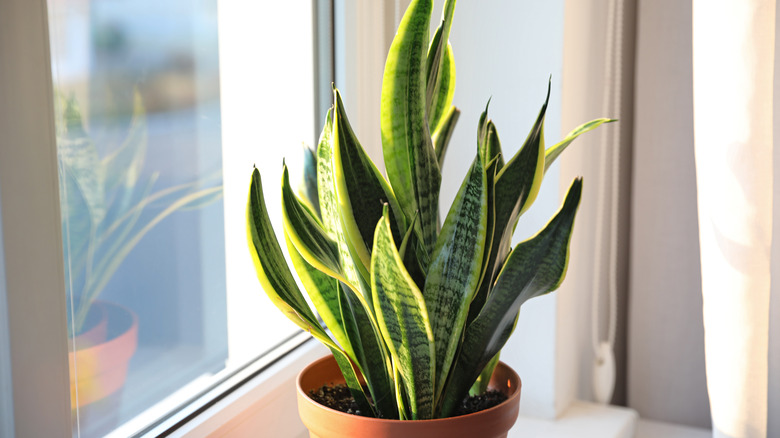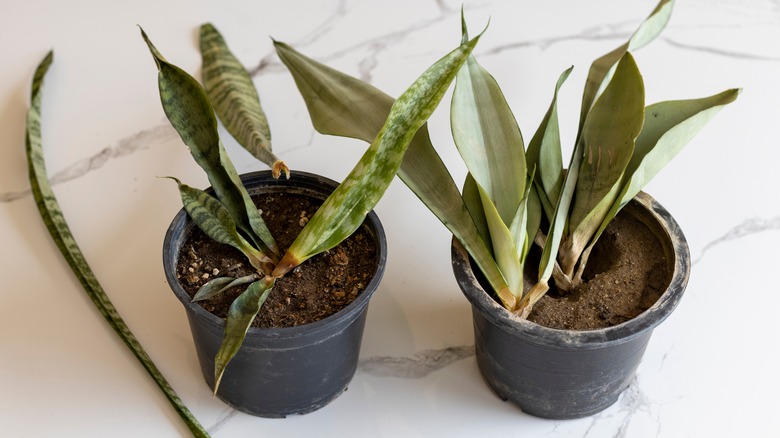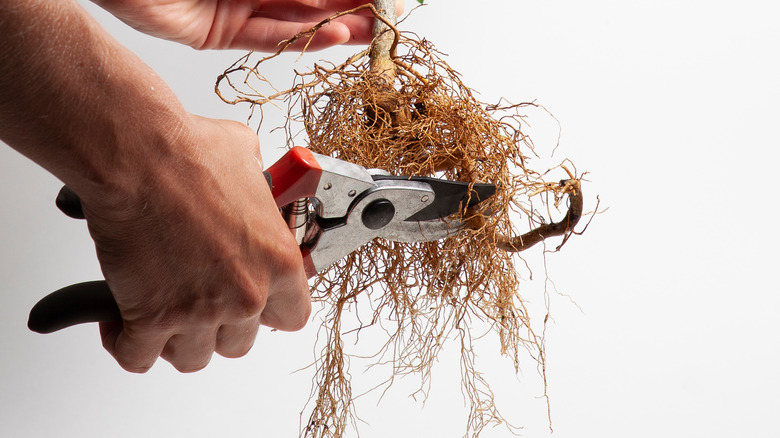What's The Best Way To Treat Root Rot On Snake Plants?
If you're looking for an incredibly low-maintenance, easy-to-care-for addition to your houseplant collection, look no further than the snake plant (sansevieria trifasciata). Also known as the mother-in-law's tongue, this tropical houseplant is beneficial in a variety of ways. Aside from its rich and rigidly tall green leaves, it's an air purifier, and improves the quality of the air you breathe by removing pollutants, per Healthline.
Snake plants are ridiculously easy to care for, requiring very little attention to thrive. In fact, they survive best in dim corners with minimal watering. Since they're succulents, they store water in their leaves and self-regulate their moisture needs. However, snake plants are not invincible. If you're noticing yours is looking a little lackluster, odds are you've given it too much attention, particularly in terms of water. While the succulent is incredibly hearty, it is susceptible to common houseplant ailments — and none more so than root rot.
How to tell if your snake plant has root rot
Root rot is one of the most common houseplant ailments, especially for plants that love dry environments like snake plants. However, root rot is usually a symptom of a more significant issue, like a fungal infection, bug infestation, or, most commonly, an overly wet environment (via Léon and George). Different plants have varying degrees of sensitivity to root rot, but succulents and cacti are particularly sensitive — snake plants included.
Annoyingly, the initial symptoms of root rot may make it look like your snake plant is thirsty. These include brown-edged and tipped leaves, wilting or drooping leaves, and a generally lackluster appearance. This is because the roots are choking due to the rot and can't take in nutrients or oxygen. One way you can guarantee it's root rot you're dealing with is by excessively wet soil. If you suspect your snake plant has fallen prey to this common ailment, unpot it immediately and inspect the roots. Healthy ones will be firm to the touch and, in the case of snake plants, white, pale green, or potentially light orange. Unhealthy roots will be mushy and weak — either dark orange or brown — and have a foul rotting smell.
How to get rid of root rot
Root rot is a severe and easily fatal houseplant ailment unless you catch and treat it quickly. The first step is to unpot the plant and remove all the soil from its roots. Next, Medic Grow recommends washing the roots under a gentle stream of tap water to remove potentially toxic soil — just be careful not to damage the sensitive roots. Soak the pot in hot soapy water if you intend to reuse it.
Then, grab a pair of very sharp and sterile shears or scissors. Cut off all of the rotted roots, and be generous, as even the smallest amount of rotted roots can affect healthy ones. In either a new pot or your sterilized one, repot the plant with fresh soil. Be careful not to add too many soil amendments, as the roots will be very sensitive at this point. Keep an eye on your snake plant, and be careful not to overwater it, waiting until the soil is bone dry to give it a small drink. Prevent root rot in the future by using a moisture meter or exercising lots of caution to avoid overly moist soil conditions. Also, make sure your snake plant's pot has adequate drainage holes.


